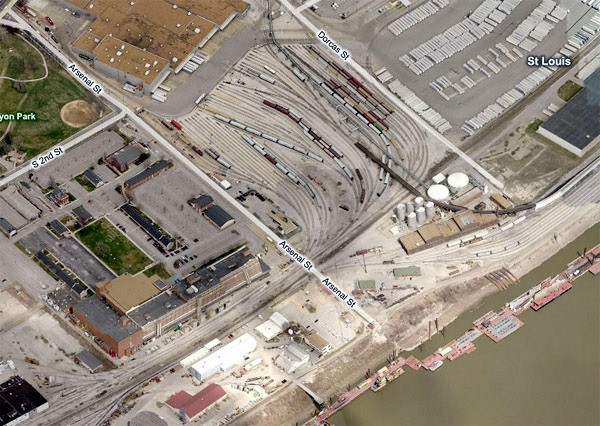 Of Trains and Beer
Of Trains and Beer
A brief article buried deep within the Post-Dispatch last week raised the possibility of completing a long-anticipated project on the South St. Louis riverfront. In-Bev, the Belgian owner of Anheuser-Busch, has been seeking Federal permission to liquidate the brewery’s 124 year old long private railway. The railway, built to deliver ice and grains to the brewery and ship out refrigerated beer, is losing over $1 million annually. Although A-B has already selected an operator for the Manufacturers Railway tracks, the US Surface Transportation Board wants A-B to fully fund MRS’s current unionized workers. A-B believes that that cost is prohibitive.
There is a solution that will help A-B save money and help the city gain access to the riverfront: donate the majority of the rail infrastructure around the brewery for the South Riverfront Trail and sell off the valuable interconnections to the north.
A-B is being required to fund the current rail workers because A-B will still retain ownership of the rail lines – by maintaining ownership A-B falls under the purview of the federal government. The most valuable portions of the MRS systems are its approach to the MacArthur (Free) bridge, trackage rights on the MacArthur Bridge, interchange in East St. Louis, and the interchange with the Missouri Pacific Riverfront Yard at Lafayette St. The remaining portion, from Lafayette south to Zepp St. has excess capacity. A-B began exclusively shipping its beer by truck several years ago and it uses the tracks only for infrequent raw material deliveries.
A Missing Piece
This corridor is significant for St. Louis because a lack of support here two decades ago precluded the southern half of the St. Louis Riverfront Bikeway. Now partly realized in the North Riverfront Trail, the original (1987) plan was for a continuous bikeway along the entire 19.5 mile riverfront of St. Louis. The goal of that project was to use the trail to catalyze recreation and development opportunities along the riverfront:
The Mississippi River is one of the most important resources of the City of St. Louis. The River has shaped the city’s history and economy, establishing an image and a spirit still associated with St. Louis today… the river still plays a role in shaping the future of the city. Its value as a resource has not diminished.
…
The bike and pedestrian path proposed for the St. Louis river corridor could be considered the first step in the gradual process of transforming the corridor into a more public space.
— St. Louis Riverfront Bikeway Feasibility Study (1987)
Today less than half of the Mississippi riverfront is publically accessible; were it not for the efforts of Trailnet to establish the North Riverfront trail a decade ago, that figure would be closer to 5%.

The Manufacturer’s Railway land is the key piece needed to realize a southern extension of the Riverfront Trail to Bellerive Park. It would connect Leonor K. Sullivan, the Bike St. Louis route on Chouteau Avenue, and already-accessible land along South Wharf Street with a potential alignment along South 1st St. between Potomac and Osceola. Such a route would also remove a significant amount of St. Louis’s portion of the Mississippi River Trail from the dangerous truck traffic of South Broadway.

South of Osceola, the trail could either divert uphill to meet with the north spur of Ohio Ave. to follow dedicated lanes on the residential section of South Broadway, or follow the 1987 plan by continuing South adjacent to the single-track Missouri Pacific Right of Way. If the trail follows the railroad, cyclists and joggers will benefit from unparalleled proximity to the river and views of the impressive limestone bluffs that give Mt. Pleasant its name.

As the 1987 report observes: “An urban trail of this length, co-existing with barges, trains, and levees, would be unique. It would become known far beyond state lines and attract even more people to St. Louis’s popular riverfront. By building the public’s interest in and demand for more extensive access to the river, the Bikeway will serve as the first step towards the evolution of the St. Louis Riverfront” [away from heavy industry].
The time is ripe for negotiations with Anheuser-Busch. All parties stand to gain something from the conversion of the Manufacturer’s Railway to the South Riverfront Trail.
The original plans for the St. Louis Riverfront Bikeway were developed during the administration of Mayor Schoemehl. The acclaimed success of the North Riverfront Trail has proved that these plans were ahead of their time. Now it is time for a younger generation of civic leadership to seize this opportunity and finish the Bikeway. It may have taken twenty four years, but the time is now!
View corridor animation from Eads Bridge South to Victor Street (inside floodwall):
View corridor on South 1st Street from Potomac to Osceola:


